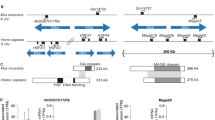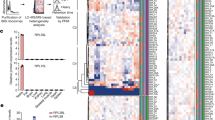Abstract
Several genes are found on both the human X and Y chromosomes in regions that do not recombine during male meiosis. In each case, nucleotide sequence analysis suggests that these X–Y gene pairs encode similar but nonidentical proteins. Here we show that the human Y– and X–encoded ribosomal proteins, RPS4Y and RPS4X, are interchangeable and provide an essential function: either protein rescued a mutant hamster cell line that was otherwise incapable of growth at modestly elevated temperatures. These findings are consistent with the hypothesis that RPS4 deficiency has a role in Turner syndrome, a complex human phenotype associated with monosomy X.
This is a preview of subscription content, access via your institution
Access options
Subscribe to this journal
Receive 12 print issues and online access
$209.00 per year
only $17.42 per issue
Buy this article
- Purchase on SpringerLink
- Instant access to full article PDF
Prices may be subject to local taxes which are calculated during checkout
Similar content being viewed by others
References
Ohno, S. Sex chromosomes and sex-linked genes. (Springer-Verlag, New York, 1967).
Goodfellow, P.J., Darling, S.M., Thomas, N.S. & Goodfellow, P.N. A pseudoautosomal gene in man. Science 234, 740–743 (1986).
Gough, N.M. et al. Localization of the human GM-CSF receptor gene to the X-Y pseudoautosomal region. Nature 345, 734–736 (1990).
Ellison, J. et al. Directed isolation of human genes that escape X inactivation. Somat. Cell molec. Genet. 18, 259–268 (1992).
Schiebel, K., Weiss, B., Wöhrle, D. & Rappold, G. A human pseudoautosomal gene, ADP/ATP translocase, escapes X-inactivation whereas a homologue on Xq is subject to X-inactivation. Nature Genet. 3, 82–87 (1993).
Schneider-Gädicke, A., Beer-Romero, P., Brown, L.G., Nussbaum, R. & Page, D.C. ZFX has a gene structure similar to ZFY, the putative human sex determinant, and escapes X inactivation. Cell 57, 1247–1258 (1989).
Fisher, E.M.C. et al. Homologous ribosomal protein genes on the human X and Y chromosomes: Escape from X inactivation and possible implications for Turner syndrome. Cell 63, 1205–1218 (1990).
Salido, E.C., Yen, P.H., Koprivnikar, K., Yu, L.-C. & Shapiro, L.J. The human enamel protein gene amelogenin is expressed from both the X and the Y chromosomes. Am. J. hum. Genet. 50, 303–316 (1992).
Mitchell, M.J., Woods, D.R., Tucker, P.K., Opp, J.S. & Bishop, C.E. Homology of a candidate spermatogenic gene from the mouse Y chromosome to the ubiquitin-activating enzyme El. Nature 354, 483–486 (1991).
Kay, G.F. et al. A candidate spermatogenesis gene on the mouse Y chromosome is homologous to ubiquitin-activating enzyme E1. Nature 354, 486–489 (1991).
Wool, I.G., Chan, Y.-L., Paz, V. & Olvera, J. The primary structure of rat ribosomal proteins: The amino acid sequences of L27a and L28 and corrections in the sequences of S4 and S12. Biochim. Biophys. Acta 1050, 69–73 (1990).
Zinn, A.R. et al. Inactivation of the Rps4 gene on the mouse X chromosome. Genomics 11, 1097–1101 (1991).
Synetos, D., Dabeva, M.D. & Warner, J.R. The yeast ribosomal protein S7 and its genes. J. biol. Chem. 267, 3008–3013 (1992).
Nishimoto, T. & Basilico, C. Analysis of a method for selecting temperature-sensitive mutants of BHK cells. Somat. Cell Genet. 4, 323–340 (1978).
Watanabe, M. et al. Molecular cloning of the human gene, CCG2, that complements the BHK-derived temperature-sensitive cell cycle mutant tsBN63—identity of CCG2 with the human X-chromosomal SCAR/RPS4X gene. J. cell Sci. 100, 35–43 (1991).
Nishimoto, T. et al. Large-scale selection and analysis of temperature-sensitive mutants for cell reproduction from BHK cells. Somat. Cell Genet. 8, 811–824 (1982).
Ashworth, A., Rastan, S., Lovell-Badge, R. & Kay, G. X-chromosome inactivation may explain the difference in viability of XO humans and mice. Nature 351, 406–408 (1991).
Hamvas, R.M. et al. Rps4 maps near the inactivation center on the mouse X chromosome. Genomics 12, 363–367 (1992).
Hayakawa, H., Koike, G. & Sekiguchi, M. Expression and cloning of complementary DNA for a human enzyme that repairs O6-methylguanine in DNA. J. molec. Biol. 213, 739–747 (1990).
Woolford, J.J. The structure and biogenesis of yeast ribosomes. Adv. Genet. 29, 63–118 (1991).
Ford, C.E., Jones, K.W., Polani, P.E., De Almeida, J.C. & Briggs, J.H. A sex-chromosome anomaly in a case of gonadal dysgenesis (Turner's syndrome). Lancet i, 711–713 (1959).
Lippe, B. Turner syndrome. Endocrinol. Metab. Clin. North Am. 20, 121–152 (1991).
Ferguson-Smith, M.A. Karyotype-phenotype correlations in gonadal dysgenesis and their bearing on the pathogenesis of malformations. J. med. Genet. 2, 142–155 (1965).
Page, D.C., Fisher, E.M., McGillivray, B. & Brown, L.G. Additional deletion in sex-determining region of human Y chromosome resolves paradox of X,t(Y;22) female. Nature 346, 279–281 (1990).
Ballabio, A. et al. Contiguous gene syndromes due to deletions in the distal short arm of the human X chromosome. Proc. natn. Acad. Sci. U.S.A. 86, 10001–10005 (1989).
Levilliers, J., Quack, B., Weissenbach, J. & Petit, C. Exchange of terminal portions of X- and Y-chromosomal short arms in human XY females. Proc. natn. Acad. Sci. U.S.A. 86, 2296–2300 (1989).
Just, W., Geerkens, C., Held, K.R. & Vogel, W. Expression of RPS4X in fibroblasts from patients with structural aberrations of the X chromosome. Hum. Genet. 89, 240–242 (1992).
Studier, F.W. & Moffatt, B.A. Use of bacteriophage T7 RNA polymerase to direct selective high-level expression of cloned genes. J. molec. Biol. 189, 113–130 (1986).
Szewczyk, B. & Kozloff, L.M. A method for the efficient blotting of strongly basic proteins from sodium dodecyl sulfate-polyacrylamide gels to nitrocellulose. Anal. Biochem. 150, 403–407 (1985).
Author information
Authors and Affiliations
Rights and permissions
About this article
Cite this article
Watanabe, M., Zinn, A., Page, D. et al. Functional equivalence of human X– and Y–encoded isoforms of ribosomal protein S4 consistent with a role in Turner syndrome. Nat Genet 4, 268–271 (1993). https://doi.org/10.1038/ng0793-268
Received:
Accepted:
Issue Date:
DOI: https://doi.org/10.1038/ng0793-268
This article is cited by
-
CRISPR/Cas9 mediated Y-chromosome elimination affects human cells transcriptome
Cell & Bioscience (2024)
-
Turner syndrome: mechanisms and management
Nature Reviews Endocrinology (2019)
-
Assessment of the key regulatory genes and their Interologs for Turner Syndrome employing network approach
Scientific Reports (2018)
-
Widespread DNA hypomethylation and differential gene expression in Turner syndrome
Scientific Reports (2016)
-
Mammalian Y chromosomes retain widely expressed dosage-sensitive regulators
Nature (2014)



